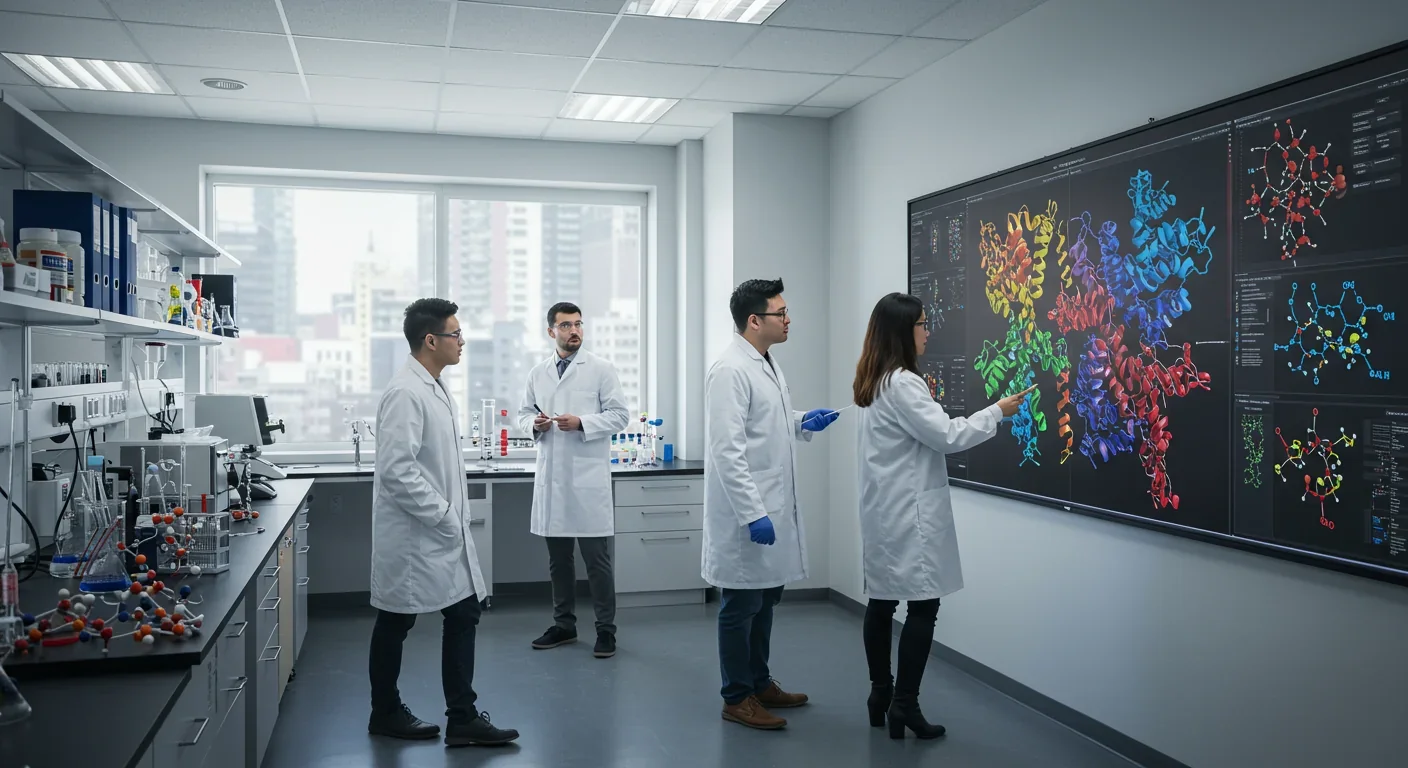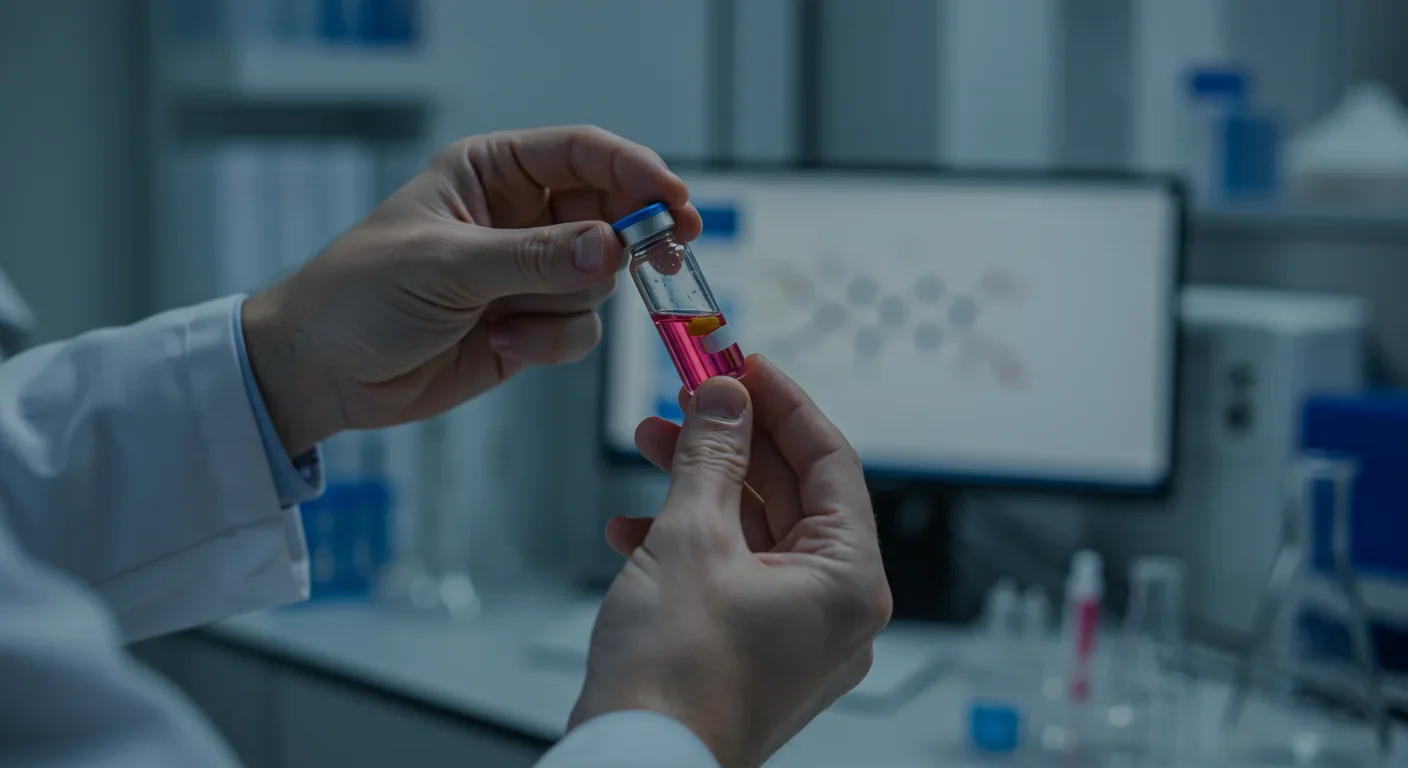Ultrafine Particles Breach Brain Barriers: Hidden Risk

TL;DR: AI systems like AlphaFold have solved the decades-old protein folding problem, predicting 200+ million structures with near-experimental accuracy. This breakthrough is slashing drug discovery timelines by 70%, enabling precision medicine for diseases like Alzheimer's and cystic fibrosis, and transforming biology from a descriptive science into a design discipline.

In the summer of 2020, a group of computational biologists gathered for what should have been a routine scientific competition. Instead, they witnessed something extraordinary. AlphaFold 2 had just scored above 90 on two-thirds of the proteins in the Critical Assessment of Structure Prediction (CASP14) contest, a benchmark normally only reached by experimental methods that take months or years. The room went silent. After half a century of trying to crack the protein folding problem, artificial intelligence had finally done what seemed impossible.
This wasn't just a technical milestone. It was the moment when biology's most stubborn puzzle yielded to machine learning, and in doing so, opened a path to treatments for diseases we'd barely understood at the molecular level.
For decades, determining a single protein's 3D structure required painstaking work. Scientists would spend years crystallizing proteins, bombarding them with X-rays, or freezing them for electron microscopy. The process was expensive, time-consuming, and often failed entirely. By 2020, after sixty years of effort, researchers had experimentally determined structures for only about 170,000 proteins.
Then AlphaFold changed everything by predicting over 200 million protein structures, making them freely available in a public database. What took a career could now happen in minutes. More importantly, the predictions were accurate enough to use for drug design, something many experts thought was decades away.
The technical achievement relied on a clever insight: instead of trying to simulate the physics of protein folding directly, AlphaFold learned patterns from all known protein structures, combined with evolutionary information from related proteins across species. The system used deep learning architectures with multiple sequence alignments, pair representations, and specialized "triangle update" modules that captured spatial relationships between amino acids.
RoseTTAFold, developed by David Baker's lab at the University of Washington, took a parallel path to similar accuracy. Both systems proved that AI could solve biology's structure problem not by understanding the underlying physics completely, but by recognizing patterns in vast amounts of data.
The pharmaceutical industry operates on brutal timelines. Developing a new drug typically takes 10-15 years and costs upward of $2.6 billion. Most candidates fail. The early stages—identifying a target protein, understanding its structure, and designing molecules that bind to it—consume years before a single molecule enters human trials.
AI-driven protein folding is collapsing these early stages dramatically. Insilico Medicine used AI-driven pipelines to deliver a preclinical candidate in 13-18 months, compared to the traditional 2.5-4 years. Exscientia reports a 70% faster lead-design cycle with an 80% reduction in upfront capital.
The mechanics are straightforward but powerful. Once you have an accurate protein structure, you can computationally screen millions of potential drug molecules to see which ones might bind effectively. One team used AlphaFold structures combined with generative chemistry to identify a CDK20 inhibitor in 30 days, synthesizing only seven molecules in the process. Traditionally, such a discovery might take years and hundreds of synthesized compounds.
This isn't just faster—it's fundamentally different. Researchers can now tackle "undruggable" targets, proteins whose structures were too complex or dynamic to characterize experimentally. They can design molecules with atomic precision, predicting not just whether a drug will bind, but exactly how it will fit into the protein's binding pocket.
The abstraction of protein structures becomes concrete when you look at specific diseases. Take Alzheimer's, where abnormal protein folding creates the toxic aggregates that destroy brain cells. Understanding the precise structure of these misfolded proteins—and the enzymes that might break them down—is critical for developing treatments. AI structure predictions are now serving as starting points for drug discovery pipelines targeting these aggregates.
For cystic fibrosis, caused by mutations in the CFTR protein, accurate structural models help researchers understand exactly how different mutations disrupt the protein's function. This enables development of precision therapies tailored to specific genetic variants, moving medicine toward true personalization.
The COVID-19 pandemic offered a real-time demonstration of AI's potential. AlphaFold released predictions of SARS-CoV-2 proteins before experimental structures were available, allowing researchers worldwide to begin modeling the virus immediately. These predictions helped inform hypotheses about viral entry mechanisms and immune response, accelerating research at a moment when every week mattered.
More recently, AlphaFold 3 expanded capabilities to predict interactions between proteins and DNA, RNA, ligands, and ions, showing a minimum 50% improvement in accuracy for these interactions compared to existing methods. This matters because most biological processes involve multiple molecules working together, not isolated proteins.

Understanding how AlphaFold works requires stepping back from the magic and looking at the engineering. The core innovation was recognizing that protein folding, while governed by physics, could be learned as a pattern recognition problem.
AlphaFold 2 uses a neural network architecture that processes amino acid sequences alongside evolutionary information from multiple sequence alignments (MSAs). The system looks at how proteins have evolved across millions of years and billions of organisms, extracting clues about which amino acids must be close together in 3D space because evolution has conserved their relationship.
The "Evoformer" module—AlphaFold 2's key component—processes this information through attention mechanisms that model pairwise relationships between residues. Triangle multiplication and triangle attention operations ensure geometric consistency, so the predicted structure obeys basic spatial constraints.
But here's where it gets interesting for the future: SimpleFold, a recent advancement, achieves competitive performance using standard transformer blocks without MSAs or triangle updates. This suggests that the essential complexity of protein folding might be captured by simpler architectures than initially thought, potentially making predictions faster and more accessible.
AlphaFold 3 introduced the "Pairformer" architecture and diffusion-based refinement, enabling it to handle not just proteins but their interactions with other biomolecules. The diffusion process gradually refines a randomly initialized structure into the final prediction, similar to how image-generation AI works.
If this transformation feels familiar, it should. We've watched technology compress decades of scientific work into hours before. The Human Genome Project took 13 years and $3 billion to sequence the first human genome. Today, you can sequence a genome in a day for less than $1,000. The pattern is consistent: initial breakthroughs require massive coordinated effort, then technology makes them routine.
But protein folding represents something qualitatively different. The genome, for all its complexity, is fundamentally a data problem—read the sequence accurately and you're done. Protein folding is a prediction problem requiring understanding of how linear sequences create 3D shapes through billions of weak interactions. It's closer to weather forecasting or quantum chemistry than to data sequencing.
The historical parallel that matters most might be the invention of X-ray crystallography itself in the early 20th century. That technology made protein structures visible for the first time, transforming biochemistry from a descriptive science into a structural one. It enabled the molecular biology revolution, the discovery of DNA's double helix, and eventually rational drug design.
AI protein folding could be this generation's crystallography—not replacing experimental methods entirely, but democratizing access to structural information and enabling a scale of inquiry that was previously impossible. Just as crystallography moved from physics labs into every biology department, AI structure prediction is becoming a standard tool.
The cascading effects on medical research are already visible. Structural biology labs are shifting focus from determining structures (now often unnecessary) to understanding dynamics, interactions, and mechanisms. The question isn't "what does this protein look like?" but "how does it move, what does it bind, and how can we modulate that?"
This enables a more sophisticated approach to drug development. Instead of finding molecules that bind to a single static structure, researchers can now model multiple conformational states of a protein and design drugs that stabilize or disrupt specific states. This is particularly important for proteins with intrinsically disordered regions, which lack fixed structures and have been largely ignored as drug targets because they were too difficult to characterize.
The democratization aspect matters too. High-confidence structural models are now available to researchers without access to X-ray crystallography or cryo-EM facilities, which require millions of dollars in equipment and specialized expertise. A graduate student anywhere with internet access can now download structures that would have been the capstone achievement of a career just a decade ago.
Academic labs in resource-limited settings can compete on equal footing with well-funded institutes, at least at the initial stages of target identification and structure-based design. This geographic leveling of the playing field could accelerate research on neglected diseases that primarily affect low-income countries.
Before declaring victory over disease, we need to acknowledge what AI folding doesn't solve. Current systems struggle with intrinsically disordered regions, multimeric complexes, and conformational dynamics. They predict static structures, but proteins are dynamic molecules that shift between states. A drug that works against a predicted structure might fail against the actual, breathing, moving protein in a cell.
Experimental validation remains essential. A Reddit discussion among biochemists highlights skepticism about AlphaFold's ability to predict truly novel protein folds outside its training distribution. The model learns from known structures, so predicting radically new folds—the kind that might appear in synthetic biology or extreme environments—is uncertain.
There's also a risk of over-reliance. Computational predictions must be complemented by experimental work to validate binding, measure kinetics, and test whether predictions hold up in physiological conditions. A beautiful predicted structure means nothing if the protein behaves differently in an actual cell.
Intellectual property questions loom large. AlphaFold 3's broader capabilities raise patent challenges around AI-generated discoveries. If an AI predicts a protein-ligand interaction that leads to a drug, who owns it? DeepMind? The researchers who used the tool? The companies that commercialize it? These questions will shape how the technology gets deployed.

The protein folding revolution is playing out differently across regions. In the United States and Europe, big pharmaceutical companies are integrating AI predictions into existing drug development pipelines, primarily to reduce costs and timelines. The focus is incremental improvement in efficiency.
In China, the approach has been more aggressive. Companies like Insilico Medicine are building entirely AI-native drug development pipelines from the ground up, using structure prediction as one component of end-to-end automated discovery. The cultural comfort with AI-first approaches and less regulatory friction around computational tools gives Chinese biotech a different innovation profile.
Meanwhile, researchers worldwide are uploading AlphaFold predictions to databases like UniProt, creating a global commons of structural knowledge. This open science ethos stands in tension with the competitive dynamics of drug development, where companies increasingly view AI tools as proprietary advantages.
Developing nations face a different calculus. The technology theoretically gives them access to the same structural information as wealthy countries, but the downstream resources needed to translate predictions into treatments—synthesis capabilities, clinical trial infrastructure, regulatory expertise—remain concentrated in high-income regions. The risk is that AI widens the gap between knowing what might work and actually delivering medicines to patients.
International collaboration will be crucial. Some experts argue that the global benefits of protein folding AI will only be realized through coordinated efforts to ensure equitable access to both the tools and their fruits. The question is whether market forces or public policy will determine how this knowledge gets deployed.
For scientists, the message is clear: computational literacy is no longer optional. Structural biologists need to understand machine learning well enough to know when to trust AI predictions and when to demand experimental validation. Medicinal chemists need to integrate computational screening into their workflow. Graduate programs are racing to update curricula.
For healthcare professionals, the timeline to impact is longer but inexorable. Within a decade, many of the drugs you prescribe will have been discovered or optimized using AI structure prediction. Understanding the technology's strengths and limitations will matter for interpreting clinical trial results and managing patient expectations.
Investors and policymakers face a different challenge: how to fund the translation of computational breakthroughs into clinical reality. AI can identify drug candidates faster and cheaper, but clinical trials remain slow and expensive. The bottleneck is shifting from discovery to validation, which may require rethinking how we fund biomedical research and regulate new therapies.
For patients and the public, the promise is personalized medicine that actually delivers. Imagine treatments designed not for average patients but for your specific genetic variant of a disease, enabled by AI's ability to model how each mutation changes protein structure and function. We're not there yet, but the path is visible.
SimpleFold's demonstration that competitive accuracy is possible with simpler architectures suggests we're still in the early innings. If protein folding can be solved with standard transformers rather than specialized modules, the technology becomes more accessible to researchers without deep expertise in structural biology. It also becomes cheaper to run, opening possibilities for massive-scale screening.
The integration with other AI tools is accelerating. Generative models can now propose novel protein sequences, which folding predictors can then evaluate for stability and function. This creates a design loop: specify what you want a protein to do, have AI generate candidates, predict their structures, test them computationally, and iterate until you have something worth synthesizing. Some labs have used this approach for designing protein binders against specific targets in weeks rather than years.
Looking further ahead, the combination of structure prediction, molecular dynamics simulations, and experimental feedback could create truly predictive models of protein function. We might move from asking "what does this protein look like?" to "what will happen if we change this amino acid?" and getting reliable answers without stepping into a lab.
But the most profound change might be conceptual. Biology has always been an empirical science, where you discover what nature has created and try to understand it. AI is making biology increasingly a design science, where you specify what you want and figure out how to build it. That shift—from discovery to design—will define the next chapter of medicine.
The protein folding problem, in a sense, was never really about proteins. It was about whether we could understand life's molecular machinery well enough to engineer it. AI has answered that question with a provisional yes. Now we get to find out what we can build with that knowledge.
What's happening in computational biology labs today is writing the script for the treatments of tomorrow. For anyone paying attention, the future is folding into view, one protein at a time.

MOND proposes gravity changes at low accelerations, explaining galaxy rotation without dark matter. While it predicts thousands of galaxies correctly, it struggles with clusters and cosmology, keeping the dark matter debate alive.

Ultrafine pollution particles smaller than 100 nanometers can bypass the blood-brain barrier through the olfactory nerve and bloodstream, depositing in brain tissue where they trigger neuroinflammation linked to dementia and neurological disorders, yet remain completely unregulated by current air quality standards.

CAES stores excess renewable energy by compressing air in underground caverns, then releases it through turbines during peak demand. New advanced adiabatic systems achieve 70%+ efficiency, making this decades-old technology suddenly competitive for long-duration grid storage.

Our brains are hardwired to see patterns in randomness, causing the gambler's fallacy—the mistaken belief that past random events influence future probabilities. This cognitive bias costs people millions in casinos, investments, and daily decisions.

Forests operate as synchronized living systems with molecular clocks that coordinate metabolism from individual cells to entire ecosystems, creating rhythmic patterns that affect global carbon cycles and climate feedback loops.

Generation Z is the first cohort to come of age amid a polycrisis - interconnected global failures spanning climate, economy, democracy, and health. This cascading reality is fundamentally reshaping how young people think, plan their lives, and organize for change.

Zero-trust security eliminates implicit network trust by requiring continuous verification of every access request. Organizations are rapidly adopting this architecture to address cloud computing, remote work, and sophisticated threats that rendered perimeter defenses obsolete.